
The rotifers, commonly called wheel animals or wheel animalcules, make up a phylum of microscopic and near-microscopic pseudocoelomate animals.

Pitcher plants are several different carnivorous plants which have modified leaves known as pitfall traps—a prey-trapping mechanism featuring a deep cavity filled with digestive liquid. The traps of what are considered to be "true" pitcher plants are formed by specialized leaves. The plants attract and drown their prey with nectar.
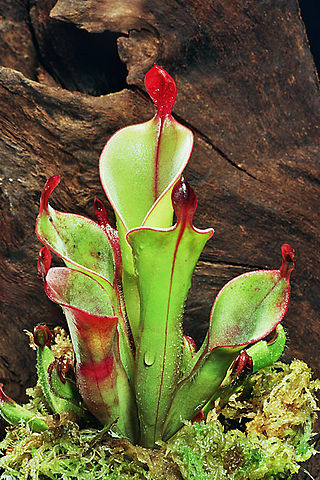
Sarraceniaceae are a family of pitcher plants, belonging to order Ericales.
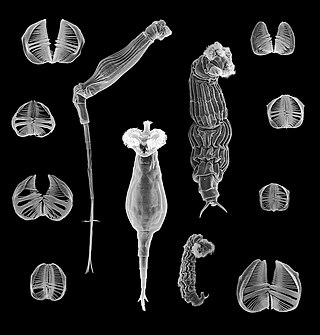
Bdelloidea is a class of rotifers found in freshwater habitats all over the world. There are over 450 described species of bdelloid rotifers, distinguished from each other mainly on the basis of morphology. The main characteristics that distinguish bdelloids from related groups of rotifers are exclusively parthenogenetic reproduction and the ability to survive in dry, harsh environments by entering a state of desiccation-induced dormancy (anhydrobiosis) at any life stage. They are often referred to as "ancient asexuals" due to their unique asexual history that spans back to over 25 million years ago through fossil evidence. Bdelloid rotifers are microscopic organisms, typically between 150 and 700 µm in length. Most are slightly too small to be seen with the naked eye, but appear as tiny white dots through even a weak hand lens, especially in bright light. In June 2021, biologists reported the restoration of bdelloid rotifers after being frozen for 24,000 years in the Siberian permafrost.
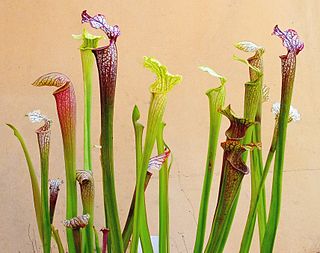
Sarracenia is a genus comprising 8 to 11 species of North American pitcher plants, commonly called trumpet pitchers. The genus belongs to the family Sarraceniaceae, which also contain the closely allied genera Darlingtonia and Heliamphora.
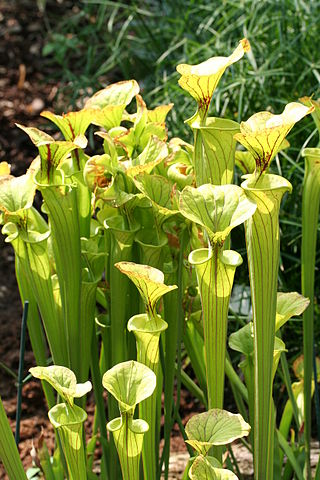
Sarracenia flava, the yellow pitcherplant, is a carnivorous plant in the family Sarraceniaceae. Like all the Sarraceniaceae, it is native to the New World. Its range extends from southern Alabama, through Florida and Georgia, to the coastal plains of southern Virginia, North Carolina and South Carolina. Populations also exist in the Piedmont, Mendocino County, California and mountains of North Carolina.

Sarracenia purpurea, the purple pitcher plant, northern pitcher plant, turtle socks, or side-saddle flower, is a carnivorous plant in the family Sarraceniaceae.
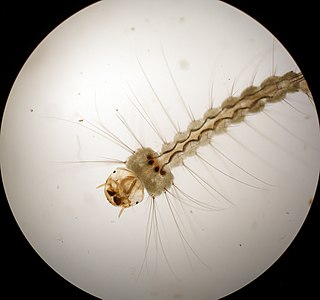
In zoology, an inquiline is an animal that lives commensally in the nest, burrow, or dwelling place of an animal of another species. For example, some organisms such as insects may live in the homes of gophers or the garages of humans and feed on debris, fungi, roots, etc. The most widely distributed types of inquiline are those found in association with the nests of social insects, especially ants and termites – a single colony may support dozens of different inquiline species. The distinctions between parasites, social parasites, and inquilines are subtle, and many species may fulfill the criteria for more than one of these, as inquilines do exhibit many of the same characteristics as parasites. However, parasites are specifically not inquilines, because by definition they have a deleterious effect on the host species, while inquilines have not been confirmed to do so.
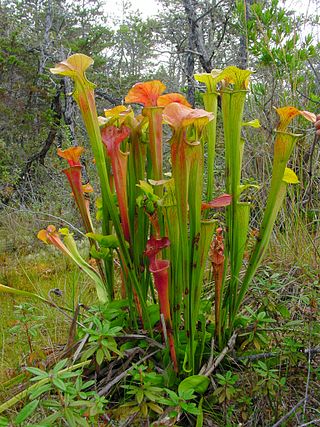
Sarracenia oreophila, also known as the green pitcherplant, is a carnivorous plant in the genus Sarracenia. It has highly modified leaves in the form of pitchers that act as pitfall traps for prey. The narrow pitcher leaves are tapered tubes that rise up to 75 centimetres from the ground, with a mouth 6 to 10 centimetres in circumference Like all the Sarracenia, it is native to North America. Sarracenia oreophila is the most endangered of all Sarracenia species, its range limited to a handful of sites in northern Alabama, North Carolina, Georgia, and—historically--Tennessee.

Sarracenia leucophylla, also known as the crimson pitcherplant, purple trumpet-leaf or white pitcherplant, is a carnivorous plant in the genus Sarracenia.

Sarracenia rosea is a species of pitcher plant in the genus Sarracenia and is sometimes known as Burk's southern pitcher plant.

Carnivorous plants are plants that derive some or most of their nutrients from trapping and consuming animals or protozoans, typically insects and other arthropods. Carnivorous plants still generate some of their energy from photosynthesis. Carnivorous plants have adapted to grow in places where the soil is thin or poor in nutrients, especially nitrogen, such as acidic bogs. They can be found on all continents except Antarctica, as well as many Pacific islands. In 1875 Charles Darwin published Insectivorous Plants, the first treatise to recognize the significance of carnivory in plants, describing years of painstaking research.

Wyeomyia smithii, the pitcher plant mosquito, is an inquiline mosquito that completes its pre-adult life cycle in the phytotelma of—that is, the water contained by—the purple pitcher plant, Sarracenia purpurea. In this microcommunity of bacteria, rotifers, protozoa, and midges, W. smithii is the top-level predator; its presence determines the bacterial species diversity within the pitcher.

Metriocnemus knabi, the pitcher plant midge, is an inquiline invertebrate found only in the phytotelma of the purple pitcher plant, Sarracenia purpurea. In this microcommunity of bacteria, rotifers, protozoa, and other dipteran larva like Wyeomyia smithii, M. knabi specializes by feeding mostly on the carcasses of drowned insects captured by the plant that collect at the bottom of the pitcher. It is found in the eastern United States, as far north as Maine and south to North Carolina.
Meadowview Biological Research Station is a non-profit 501(c)(3) organization dedicated to preserving and restoring rare wetland plants, habitats and associated ecosystems on the coastal plain of Maryland and Virginia. It was created in 1995 with the specific goal or restoring the rare yellow pitcher plant, the purple pitcher plant, and associate species to pitcher plant bogs or seepage wetlands in their historic ranges.

The Sifton Bog Environmentally Significant Area is a wetland jointly administered by the city of London, Ontario and the Upper Thames River Conservation Authority. It is located west of Hyde Park Road and south of Oxford Street inside the city limits of London, Southern Ontario, Canada. It is a Class 2 provincially significant wetland.
Purpurea, purple in Latin, may refer to:

Black Tern Bog State Natural Area is a Wisconsin Department of Natural Resources-designated State Natural Area featuring 20 acres of quaking sphagnum bog surrounding two small seepage lakes situated in a pitted outwash plain. The bog is rich in plant species, such as sundews, pitcher plant, bogbean, and bog rosemary, as well as three species of bog orchids: swamp pink, grass pink, and rose pogonia. The state-endangered bog rush also grows here. Birds known to nest here include black tern, American bittern, killdeer, and mallards.
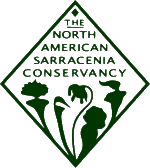
The North American Sarracenia Conservancy (NASC) is a 501(c)(3) non-profit organization dedicated to habitat conservation. Founded in 2005, the Conservancy was granted tax-exempt status in January 2009. The main focus of the Conservancy is the conservation and preservation of the natural habitats and genetic diversity of the Sarracenia pitcher plants. Sarracenia is a genus of carnivorous plant that trap prey in tube-shaped, hollow leaves, which in some species hold rain water. Species range from the southeastern United States, up the coastal plain, and into the Great Lakes and Canada. Within their range the plants naturally occur in sphagnum bogs, swamps, fens, and flooded plains.
Papaipema appassionata, the pitcher plant borer, is a species of moth described by Leon F. Harvey in 1876. It is native to North America, where it has been recorded from Florida, Maine, Maryland, Massachusetts, Michigan, Minnesota, New Brunswick, Quebec, Rhode Island, South Carolina and Wisconsin. It is listed as threatened in the US state of Connecticut.
















